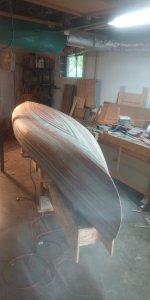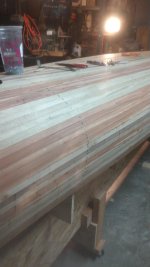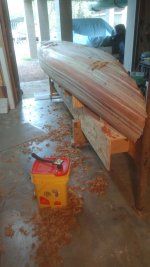RoyBrew I have not glassed the inside yet. Waiting for a replacement orbital sander pad to arrive to sand the inside seal coat. Then I will play with inside fiberglassing. Just reading about it and preparing from that standpoint. Happy to hear that my build has encouraged you to build your own. I too was inspired by the many on this forum and the sources that I have called out in some of my videos. It really is relaxing as you are finding. Finding the time is the tricky part.
-
Happy National Shrimp Day! 🦐🍤
You are using an out of date browser. It may not display this or other websites correctly.
You should upgrade or use an alternative browser.
You should upgrade or use an alternative browser.
Roy's Mystery Wood Canoe
- Thread starter Roybrew
- Start date
I have a question about pulling staples. What do you do when they break off in the strip?
I use small needle nose pliers to extract the piece. If you are very careful with the point of an exacto knife or similar thin pointed knife, you can usually work the piece out far enough to grab it with the needle nose.
Thank you both. I thought I'd better ask before doing surgery on it. I figured as much, but figured it's better to ask first. I've had to extract Brad nails and such frow wood projects before and sometimes a person can cause more damage then leaving it alone.
Roy
Roy
Surgery was required on a couple staples for me personally, otherwise the staple stubs would interfere with the sanding process....in other words tear the pads up pretty good. I excavated to a certain extent but had great luck with needle nose as well.
I closed it up today. The last center strip was 3/8 wide by a foot long. I pondered on it before I glued it in. Just didn't seem right being so small, and well sort of insignificant. I'm happy with it so far. I always think about how I could've done better, or added some special features. I'll strive to improve on the next one. I tried to keep this as a hobby, and not let it consume my time. Now on to the next step that I am looking forward.
Attachments
The pieces of masking tape are pointing to the broken staples.
Thank you DC.
My wife was wanting to know if it was going to break when I get it done. Told her she could wear her life jacket when she tries it out for the first time .
.
My wife was wanting to know if it was going to break when I get it done. Told her she could wear her life jacket when she tries it out for the first time
Looks great!
I guess joke not funny. Oh well, smoothing the hull so I am hoping to be glassing in a couple of weeks. I was looking at RAKA epoxies. The cost and process of fiberglassing scares me, but I'll figure it out. How much fiberglass and epoxy does a 16 foot canoe usually require? I figure 15 yards 6oz Eglass, 32 feet plus another 13 for the football patch on bottom, and 2 gallon 127 epoxy with 1 gallon 350 non-blushing hardner. Does that sound right? Is that enough for this 16 foot canoe?
I have another question concerning the finished hull thickness. I started out with 3/16 thickness for the strips. Majority of the strips are sassafras and eastern red cedar. I have shaved some? off just for the smoothing process. I have a fear of getting the hull to thin. I don't plan to be doing any white water running with it, but I I do weigh about 220#s and my wife is around 140 ish. Am I ok with 6oz inside and out and football patch on outside?
One more stupid question and I'll leave you all alone. I do have several gaps and voids to fill. Should I order a little more resin for this? And for filling gaps and glassing, is the thin resin good for all or do I need the medium or thick resin?
Getting close to the no turn back stage, so I'm getting nervous. I greatly appreciate any advice I can get.
Thanks Y'all
Roy
I have another question concerning the finished hull thickness. I started out with 3/16 thickness for the strips. Majority of the strips are sassafras and eastern red cedar. I have shaved some? off just for the smoothing process. I have a fear of getting the hull to thin. I don't plan to be doing any white water running with it, but I I do weigh about 220#s and my wife is around 140 ish. Am I ok with 6oz inside and out and football patch on outside?
One more stupid question and I'll leave you all alone. I do have several gaps and voids to fill. Should I order a little more resin for this? And for filling gaps and glassing, is the thin resin good for all or do I need the medium or thick resin?
Getting close to the no turn back stage, so I'm getting nervous. I greatly appreciate any advice I can get.
Thanks Y'all
Roy
Attachments
Roybrew, I went with US Composites for the epoxy and 6 oz glass. I have used about 1 1/4 gallons resin thus far and about 3/4 of a gallon of hardener. The remaining epoxy accounts for two seal coats, three fill coats on the exterior and one fill coat on the inside. I may have just enough hardener to finish my next two fill coats. Consider using US Composites if cost is a factor. $128 for the two gallons of resin and 1 gallon of hardener. I have used what most people use on this board for glassing and that is 6oz sheet on the inside and outside and a football layer. 17 yds is what I ordered per Jim Dodd’s recommendation and it was spot on. I ordered the 60” wide and probably could have shortened that dimension a touch but I didn’t want to risk it.
I too had the feeling of sanding too much and the hull becoming too thin, but what I have observed is with the outside done and the seal coat and first filler coat done on the inside, the hull is harder then woodpecker lips! Pretty rugged! Epoxy is amazing stuff.
I will add, I started with 1/4” strips and I assume I am probably at 3/16” now. In regard to filling with epoxy I only had to mix a couple batches of resin, hardener, cedar flour and colloidal silica. My recommendation here is to tape around the areas that require filling. I do have some discoloration from skipping this step and I wish I hadn’t. So you will want to basically establish a boundary for where you will be filling.
Your project looks great!
I too had the feeling of sanding too much and the hull becoming too thin, but what I have observed is with the outside done and the seal coat and first filler coat done on the inside, the hull is harder then woodpecker lips! Pretty rugged! Epoxy is amazing stuff.
I will add, I started with 1/4” strips and I assume I am probably at 3/16” now. In regard to filling with epoxy I only had to mix a couple batches of resin, hardener, cedar flour and colloidal silica. My recommendation here is to tape around the areas that require filling. I do have some discoloration from skipping this step and I wish I hadn’t. So you will want to basically establish a boundary for where you will be filling.
Your project looks great!
As Dave recommends, a Three gallon Kit is the way I go. Yeah ! You will have plenty extra. It's a safety barrier ! I use the extra for other things too.
You will be fine Roy !
Get everything lined up before you mix that first cup.
Enlist at least one helper !
Stay with the wet out coat, until it it's cured enough that bubbles won't raise from the wood.
You can do it !
Good Luck !
Jim
You will be fine Roy !
Get everything lined up before you mix that first cup.
Enlist at least one helper !
Stay with the wet out coat, until it it's cured enough that bubbles won't raise from the wood.
You can do it !
Good Luck !
Jim
I second what Jim said about staying with the wet out coat. I have three spots on the inside that got away from me. Got busy doing other things and now I need to fix it (somehow). Stay with the wet out coat. Take it from a rookie as well!
Awesome! Thanks DC, I remember now about US Composites I'll be looking that up. Your wood looks great by the way. I like the dark spots, it shows character.
Thanks for the advice and encouragement Jim. I will be doing the seal coat first, and I'm sure my wife will assist me. She is all on board of this project, but she was the one scaring me about the hull being to thin, she loves short day trips canoeing with me.
I'll post when I make progress.
Wood pecker lips? That's a good one.
Roy
Thanks for the advice and encouragement Jim. I will be doing the seal coat first, and I'm sure my wife will assist me. She is all on board of this project, but she was the one scaring me about the hull being to thin, she loves short day trips canoeing with me.
I'll post when I make progress.
Wood pecker lips? That's a good one.
Roy
I usually just fill holes and cracks with standard wood filler, the kind you buy in a tube. There are enough varieties that I can colour match pretty easily. Filling cracks or holes doesn't add any strength, it's merely to facilitate the glass and epoxy, so there are no gaps where the glass won't be filled. The wood filler I use is very friendly, does not stain the hull, and sands off very easy. I found when I used thickened epoxy, it sanded off hard.
Usually people will wet out and fill with the same epoxy. My preferred method is to wet out with a very thin epoxy and fill with a thicker one. System three is great for this, as you can wet out with Clear coat, a very thin epoxy, and then fill with the general purpose epoxy. However, on my last few builds I have just used the same epoxy for wetting out and filing.
I'm not a believer in the seal coat, haven't noticed any difference on the many boats I have built.
I would only put the wet out coat on the inside of the canoe, no fill coats. Fill coats do not add strength, and the slightly textured feel of the glass on the inside can be helpful. Fill coats on the inside will add weight, and you will have to sand again.
Glassing the outside of the hull is actually one of the easiest parts of the entire build, and can be a very pleasant experience as you see the colours come to life.
Usually people will wet out and fill with the same epoxy. My preferred method is to wet out with a very thin epoxy and fill with a thicker one. System three is great for this, as you can wet out with Clear coat, a very thin epoxy, and then fill with the general purpose epoxy. However, on my last few builds I have just used the same epoxy for wetting out and filing.
I'm not a believer in the seal coat, haven't noticed any difference on the many boats I have built.
I would only put the wet out coat on the inside of the canoe, no fill coats. Fill coats do not add strength, and the slightly textured feel of the glass on the inside can be helpful. Fill coats on the inside will add weight, and you will have to sand again.
Glassing the outside of the hull is actually one of the easiest parts of the entire build, and can be a very pleasant experience as you see the colours come to life.
I usually just fill holes and cracks with standard wood filler, the kind you buy in a tube. There are enough varieties that I can colour match pretty easily. Filling cracks or holes doesn't add any strength, it's merely to facilitate the glass and epoxy, so there are no gaps where the glass won't be filled. The wood filler I use is very friendly, does not stain the hull, and sands off very easy. I found when I used thickened epoxy, it sanded off hard.
Usually people will wet out and fill with the same epoxy. My preferred method is to wet out with a very thin epoxy and fill with a thicker one. System three is great for this, as you can wet out with Clear coat, a very thin epoxy, and then fill with the general purpose epoxy. However, on my last few builds I have just used the same epoxy for wetting out and filing.
I'm not a believer in the seal coat, haven't noticed any difference on the many boats I have built.
I would only put the wet out coat on the inside of the canoe, no fill coats. Fill coats do not add strength, and the slightly textured feel of the glass on the inside can be helpful. Fill coats on the inside will add weight, and you will have to sand again.
Glassing the outside of the hull is actually one of the easiest parts of the entire build, and can be a very pleasant experience as you see the colours come to life.
I have discovered that the seal coat is a dreaded step in the process. I wondered the importance or at least the strong recommendation by the resource that I am using to seal coat. I do understand that there is a potential for there not to be as many bubbles that form from seal coating, but I have to agree with Rob that maybe next time I will go straight to the wet out coat after filling with something other than thickened epoxy. All the additional epoxy applications equal much more sanding. I would like to reduce that in the future.
maybe next time I will go straight to the wet out coat after filling with something other than thickened epoxy. All the additional epoxy applications equal much more sanding. I would like to reduce that in the future.
For me there is no extra sanding to speak of when I fill cracks/holes/gaps with thickened epoxy before fiberglass. I fill with thickened epoxy before the last round of sanding (hull is almost perfect at this point). I apply the thickened epoxy with a plastic squeegee. This fills the hole/gap but wipes it off flush with the rest of the hull with virtually no buildup. Once the epoxy cures I do the final round of sanding on the entire boat, which cleans up my patch jobs at the same time.
Generally I'll do all my initial sanding and filling of holes in one day. I use a fast hardener for the thickened epoxy and then, 24 hours later, I do the final sanding and then fiberglass immediately afterwards. In other words, even when I'm using thickened epoxy to fill my gaps the fiberglass will go on the outside the day after the staples are pulled.
Alan
Last edited:
Similar threads
- Replies
- 17
- Views
- 311
- Replies
- 14
- Views
- 701



